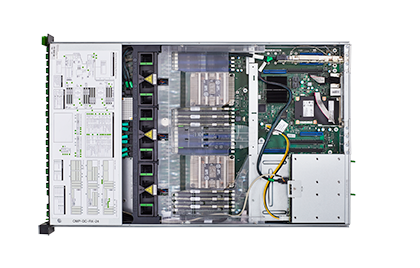The FUJITSU Server PRIMERGY RX2540 M5 is the new 2U dual socket rack server for high usability, scalability and cost-efficiency. Its Intel® Xeon® Processor Scalable Family CPUs in conjunction with DDR4 memory technology with up to 3TB up to 12x Intel® Optane™ DC Persistent Memory NV-DIMM modules increases performance to meet the requirements for data center processing, enterprise applications as well as collaboration. The modular design offers excellent expandability of up to 28 disk drives, up to 8 PCIe Gen3 expansion cards, and best-in-class energy efficiency thanks to two hot-plug power supplies with up to 96% efficiency meet the future demands of data growth. To complete the picture, DynamicLoM makes network connections more flexible and ready for future modifications. The Cool-safe® Advanced Thermal Design ensures operation in higher ambient temperatures resulting in lower OPEX.
FUJITSU PRIMERGY RX2540 M5
- BM00361
- Fujitsu
| Chipset | Intel® C624 |
|---|---|
| Mainboard type | D3384-B |
| Product Type | Dual Socket Rack Server |
| Processor | Intel® Xeon® Processor Scalable Family 1 - 2 |
| Memory | 8 GB - 7.5 TB, DIMM (DDR4 / DDR-T for non-volatile memory modules) |
| Memory protection | Advanced ECC, Memory Scrubbing, SDDC, Rank sparing memory support, Memory Mirroring support |
| Drives (optional) | DVD supermulti, ultraslim, SATA I RDX Drive, 100 MB/s, 320 GB, 500 GB, 1 TB, 2 TB, USB 3.0 LTO6HH Ultrium, 160 MB/s, 2,500 GB, SAS 6Gb/s LTO7HH Ultrium, 300 MB/s, 2,500 GB, SAS 6Gb/s |
| PCI-Express 3.0 x8 | 3 x Low profile (2nd processor required for slot 4) |
| PCI-Express 3.0 x16 | 3 x Low profile (2nd processor required for slot 5 and 6) |
| Slot Notes | One PCIe Gen3 x8 slot may be occupied with a Modular RAID controller if configured. Important: 3 PCIe slots are supported with the first processor. 6 PCIe slots are supported with two processors. PCIe riser card options can expand number of slots by two (max. 8 in total) and support max. 4 full height slots. Possible slot length described in relevant system configurator. |
| Accessible drive bays | 1 x 5.25/0.4-inch for CD-RW/DVD |














